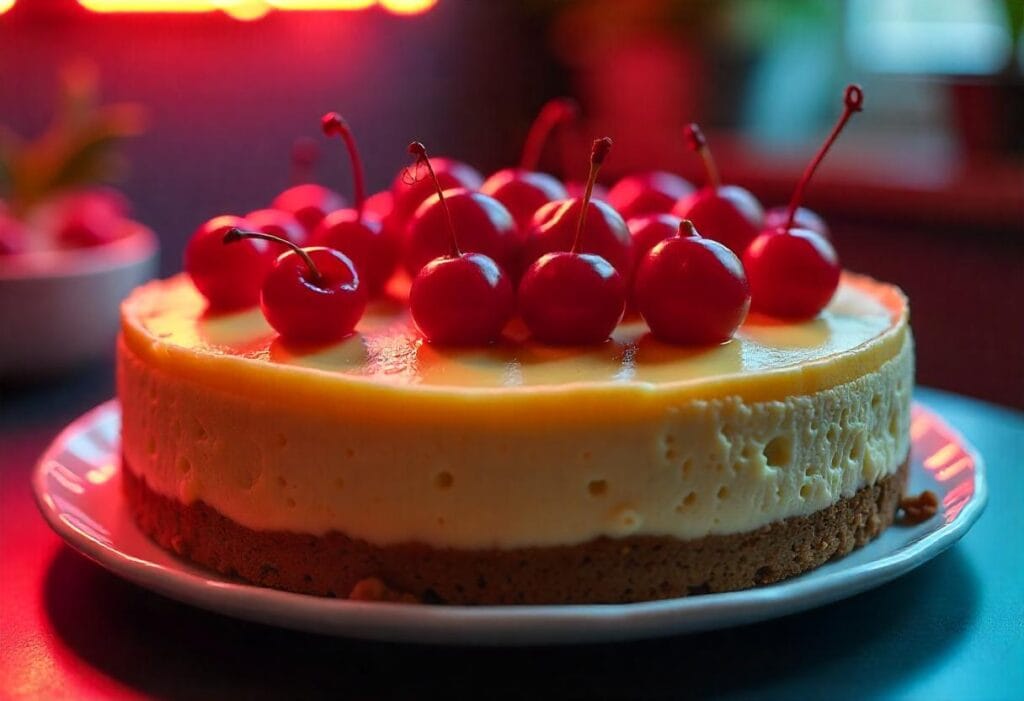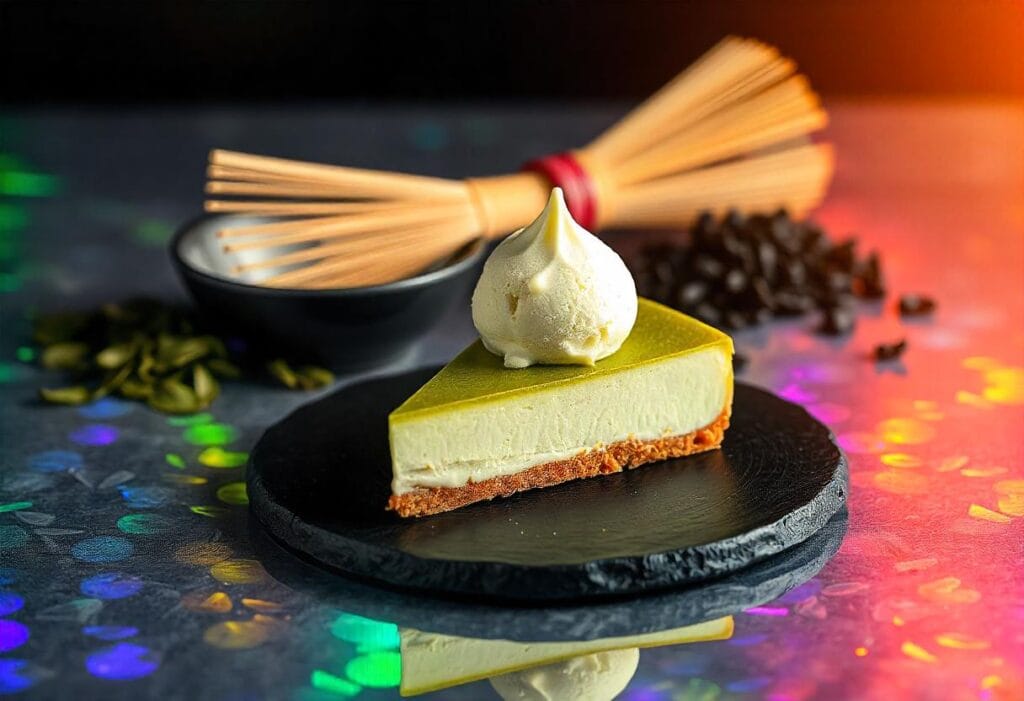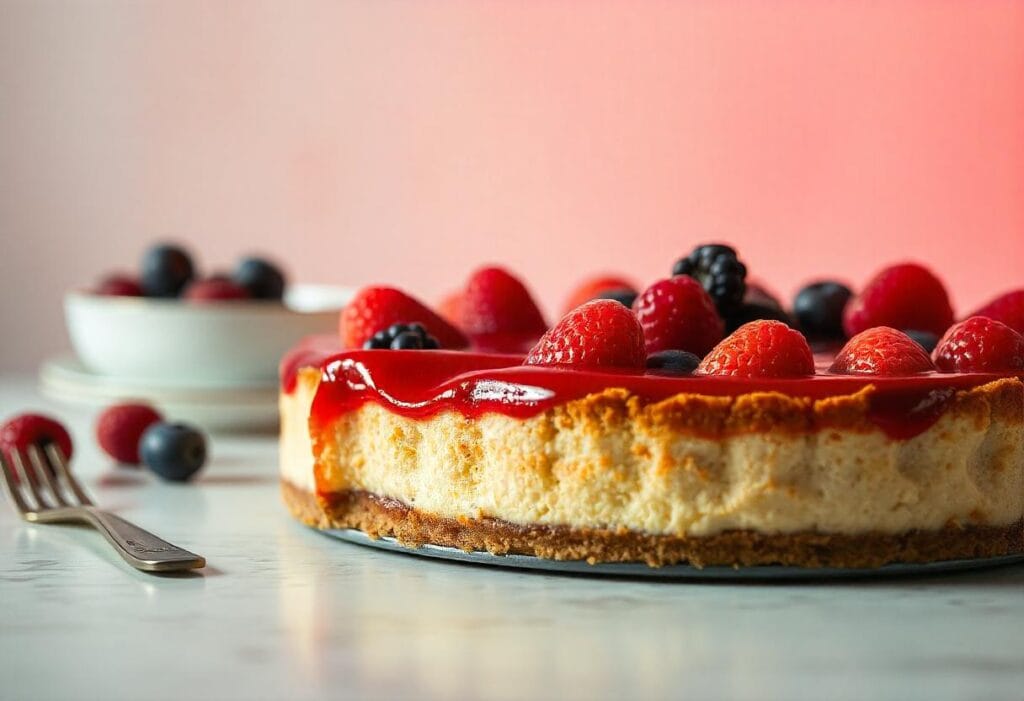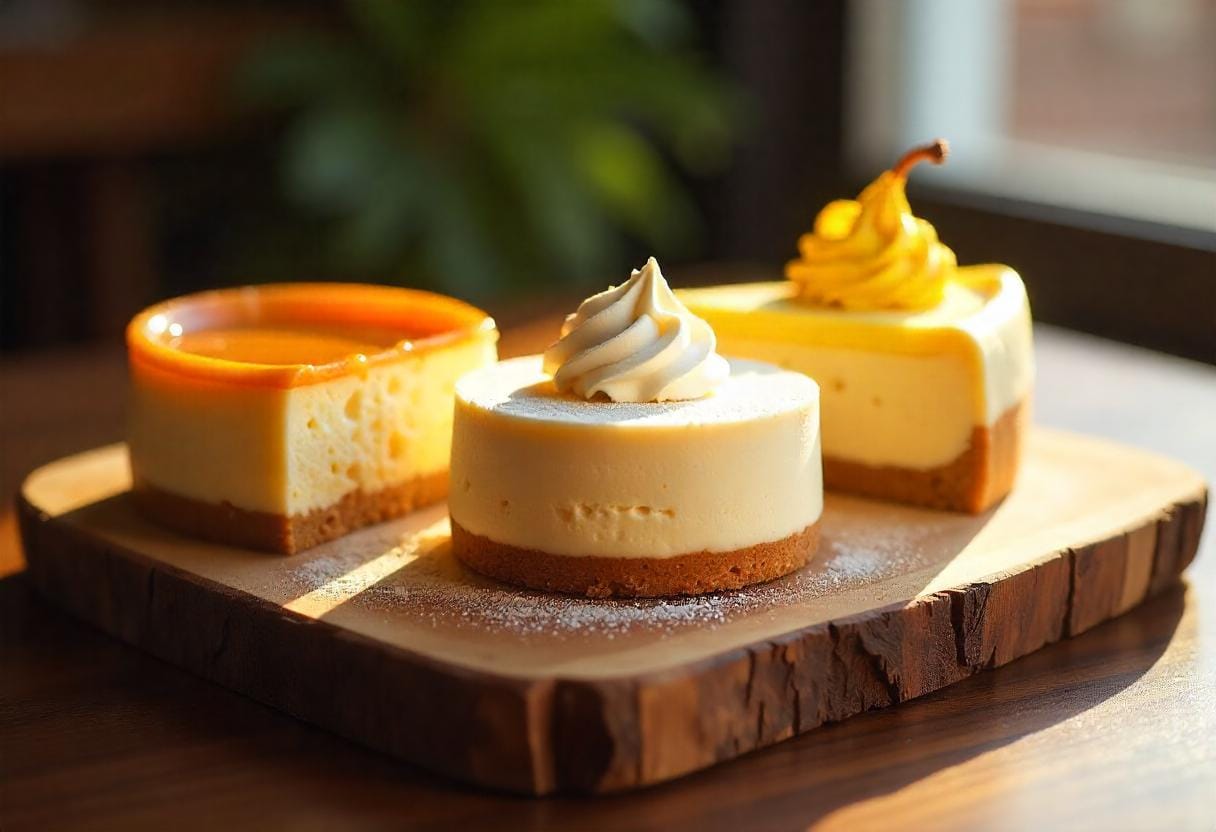What are the three types of cheesecake? 🍰 Cheesecake is one of the most beloved desserts, offering a perfect balance of creamy richness and satisfying sweetness. But did you know that there are three main types of cheesecake, each with its own unique personality? Let’s dive into this creamy, dreamy world to uncover the secrets behind New York-style, Japanese, and no-bake cheesecakes
Understanding Cheesecake: A Sweet Overview
Cheesecake is like a dessert chameleon—versatile yet distinctive. At its core, it’s made with cream cheese, sugar, eggs, and a buttery crust. Yet, what sets one cheesecake apart from another is the method of preparation and the texture. Some cheesecakes are dense and rich, while others are light and airy, almost like eating a sweet cloud.
Historically, cheesecake dates back to ancient Greece, where athletes were served an early version as an energy booster. Over time, cultures worldwide have adapted and transformed this dessert into what we know and love today.
The Three Main Types of Cheesecake
Cheesecake lovers, rejoice! Each type of cheesecake caters to a specific taste and texture preference.
New York-Style Cheesecake: Classic and Creamy
New York-style cheesecake is the dessert equivalent of a heavyweight champion—rich, dense, and oh-so-satisfying. It’s made with cream cheese, heavy cream, and eggs, baked to achieve a thick consistency that holds its own without needing any extra flourishes.
What makes it stand out? Its flavor. New York-style cheesecake is bold and tangy, making it a favorite for those who love an intense dessert experience.
“A good New York cheesecake should have a texture so creamy it feels like velvet on your tongue.”

Japanese Cheesecake: Light and Fluffy
If New York cheesecake is the heavyweight, Japanese cheesecake is the ballet dancer—light, airy, and elegantly understated. It combines cream cheese with egg whites beaten into stiff peaks, giving it a texture that’s more like a soufflé than a traditional cheesecake.
This type of cheesecake is perfect for those who prefer a less sweet, more delicate dessert. Think of it as the perfect balance between flavor and texture, often served without heavy toppings to let its simplicity shine.

No-Bake Cheesecake: Simple and Convenient
No-bake cheesecake is the ultimate crowd-pleaser for those who don’t want to deal with the complexities of baking. It relies on cream cheese and whipped cream for its texture, which is firmed up in the refrigerator rather than the oven.
It’s a versatile dessert—you can whip one up in no time, and it’s ideal for experimenting with different flavors and toppings. Whether you like fruity, chocolaty, or even nutty, no-bake cheesecake has your back.

What Sets These Cheesecakes Apart? Key Differences
Now, let’s break down the key differences between these three types of cheesecakes.
| Feature | New York-Style | Japanese | No-Bake |
|---|---|---|---|
| Texture | Dense and creamy | Light and airy | Smooth and soft |
| Preparation Method | Baked in an oven | Steam-baked or slow-baked | Refrigerated, no baking |
| Sweetness Level | Moderately sweet | Mildly sweet | Adjustable |
| Best Paired With | Fruit toppings, sauces | Simple syrups | Whipped cream, fruits |
Common Challenges in Making Cheesecake
Cheesecake may be delicious, but it’s no stranger to culinary challenges. Have you ever baked one only to see cracks on top or a soggy crust? You’re not alone!
Cracked Tops: Causes and Solutions
Cracks are the bane of a baker’s existence, often caused by overbaking or sudden temperature changes. To prevent them:
- Always use a water bath to maintain even heat distribution.
- Let your cheesecake cool gradually by leaving it in the oven with the door slightly ajar after baking.
« A cracked cheesecake doesn’t mean it’s ruined—it just means it’s rustic! »
Achieving the Perfect Texture
For New York-style, aim for a creamy yet firm consistency. Japanese cheesecake requires gentle handling to keep its airy structure intact, while no-bake cheesecake depends on proper chilling time.
- Pro Tip: Always use room-temperature ingredients to avoid lumps in your batter.
Step-by-Step Guide to Making Each Type of Cheesecake
Cheesecake-making might feel intimidating, but with the right techniques, it’s as satisfying as the first bite of a perfect slice. Let’s roll up our sleeves and dive into the recipes for New York-style, Japanese, and no-bake cheesecakes.
New York-Style Cheesecake Recipe
New York-style cheesecake is a classic that deserves its spot in every dessert lover’s heart. Here’s how to make it:
Ingredients
| Ingredient | Quantity |
|---|---|
| Cream cheese (softened) | 32 oz (4 packs) |
| Granulated sugar | 1 cup |
| Sour cream | 1 cup |
| Heavy cream | ½ cup |
| Eggs | 4 large |
| Vanilla extract | 1 tsp |
| Graham cracker crust | Pre-made or homemade |
Instructions
- Preheat your oven to 325°F (163°C).
- In a large bowl, beat cream cheese and sugar until smooth.
- Add sour cream, heavy cream, and vanilla extract. Mix well.
- Beat in eggs one at a time, ensuring the batter is smooth.
- Pour the mixture into the graham cracker crust.
- Place the pan in a water bath and bake for 1 hour.
- Turn off the oven and let the cheesecake cool inside with the door ajar.
- Chill in the refrigerator for at least 4 hours before serving.
« Pro Tip: For extra decadence, top with cherry compote or chocolate ganache! »
Japanese Cheesecake Recipe
Light and airy, Japanese cheesecake is a masterpiece of balance and finesse.
Ingredients
| Ingredient | Quantity |
|---|---|
| Cream cheese | 8 oz |
| Milk | ½ cup |
| Butter (unsalted) | 2 tbsp |
| Eggs (separated) | 3 large |
| Cake flour | ¼ cup |
| Cornstarch | 2 tbsp |
| Granulated sugar | ½ cup |
| Lemon juice | 1 tsp |
Instructions
- Preheat the oven to 320°F (160°C). Line a springform pan with parchment paper.
- Melt cream cheese, milk, and butter in a heatproof bowl over a water bath. Stir until smooth.
- Sift in cake flour and cornstarch. Mix gently.
- Add egg yolks and lemon juice. Combine well.
- In a separate bowl, beat egg whites until stiff peaks form, gradually adding sugar.
- Fold egg whites into the batter in three additions.
- Pour batter into the pan and place it in a larger pan filled with hot water.
- Bake for 50–60 minutes. Cool completely before removing from the pan.
« Did you know? Japanese cheesecake is often called ‘cotton cheesecake’ for its dreamy texture. »
No-Bake Cheesecake Recipe
Perfect for beginners and those short on time, no-bake cheesecake is a lifesaver.
Ingredients
| Ingredient | Quantity |
|---|---|
| Cream cheese (softened) | 16 oz (2 packs) |
| Heavy whipping cream | 1 cup |
| Powdered sugar | ¾ cup |
| Lemon juice | 1 tbsp |
| Vanilla extract | 1 tsp |
| Graham cracker crust | Pre-made or homemade |
Instructions
- In a large bowl, beat cream cheese until fluffy.
- Add powdered sugar, vanilla extract, and lemon juice. Mix well.
- In a separate bowl, whip the heavy cream until stiff peaks form.
- Gently fold the whipped cream into the cream cheese mixture.
- Spread the mixture evenly into the graham cracker crust.
- Refrigerate for at least 4 hours or overnight to set.
« For an extra burst of flavor, swirl in some raspberry jam before chilling! »
Popular Cheesecake Toppings and Pairings
Let’s be honest—cheesecake is fabulous on its own, but the right topping can elevate it to dessert royalty.
Classic Toppings: Fresh Fruits and Syrups
- Fresh Berries: Strawberries, blueberries, or raspberries add a tangy contrast to the rich cheesecake.
- Caramel or Chocolate Syrup: Perfect for a decadent finish.
Unique Twists: Chocolate Ganache and Savory Options
- Chocolate Ganache: Pour a glossy layer of ganache over your cheesecake for a luxurious touch.
- Savory Additions: Yes, you read that right. Try a layer of spiced nuts or a drizzle of honey for a sophisticated flavor twist.
« The best cheesecake toppings are the ones that make your taste buds dance! »
Healthier Alternatives and Adjustments
Cheesecake doesn’t have to be a guilty pleasure. With a few tweaks, it can fit into your health-conscious lifestyle.
Low-Sugar Cheesecake Variations
Replace granulated sugar with alternatives like stevia or monk fruit sweetener. This simple change can significantly reduce the calorie count without compromising on taste.
Gluten-Free and Vegan Options
- Use almond flour or gluten-free graham crackers for the crust.
- Substitute dairy-free cream cheese and coconut cream for a vegan-friendly version.
« Healthy cheesecakes prove that you can have your cake and eat it too! »
The Science Behind Cheesecake Perfection
Cheesecake is more than just mixing ingredients and hoping for the best. It’s a precise art and a bit of science. The combination of fats, proteins, and sugars in cheesecake interacts during the baking process (or chilling, for no-bake types) to create its distinct textures and flavors.
Why Does Cheesecake Crack?
Let’s address the most common heartbreak for bakers: cracks in your beautiful cheesecake. The main culprit? Overmixing the batter or sudden temperature shifts. When air gets trapped in the batter, it expands in the oven and contracts as it cools, leading to those unsightly fissures.
Here’s how to avoid it:
- Don’t overbeat the batter. Mix just until ingredients are incorporated.
- Use a water bath. The steam creates a humid environment, reducing the risk of cracks.
- Cool slowly. Cheesecake hates sudden changes in temperature. Treat it gently by leaving it in the oven after turning off the heat.
« Remember, cracks in cheesecake are like wrinkles on a wise face—they tell a story. Cover them with toppings, and no one will know! »
Fun Facts About Cheesecake
Cheesecake isn’t just a modern dessert—it has an impressive history and cultural significance.
- Ancient Beginnings: The first recorded cheesecake was served at the inaugural Olympic Games in 776 BCE.
- Worldwide Love: From Italian ricotta cheesecake to Polish sernik, nearly every culture has its version of this creamy dessert.
- Cheesecake Day: Yes, it exists! Celebrate National Cheesecake Day on July 30th by indulging in your favorite slice.
« Cheesecake isn’t just a dessert; it’s a global ambassador of sweetness! »
Cheesecake Variations Around the World
While New York, Japanese, and no-bake cheesecakes are the stars of this article, the world is full of delightful cheesecake variations.
Italian Ricotta Cheesecake
Unlike the cream cheese-based versions, Italian cheesecake uses ricotta cheese, making it lighter and less sweet. It’s often flavored with lemon zest or almond extract, giving it a refreshing twist.
German Käsekuchen
Made with quark (a soft cheese), this cheesecake is firm yet creamy. It’s less rich than its American counterpart, making it a popular everyday dessert in Germany.
French Cheesecake
Known for its delicate texture, French cheesecake often incorporates fromage blanc and a touch of gelatin. It’s typically not as dense, appealing to those who prefer a lighter dessert.
« Travel the world one cheesecake slice at a time! »
Cheesecake and Nutrition: What You Need to Know
Let’s get real—cheesecake isn’t exactly health food, but it’s worth every calorie. Here’s a quick look at what’s inside your favorite dessert:
Nutrition Facts: New York-Style Cheesecake (Per Slice)
| Nutrient | Amount |
|---|---|
| Calories | 350–450 kcal |
| Protein | 7–10 g |
| Fat | 25–30 g |
| Sugar | 20–30 g |
| Fiber | 0–1 g |
While rich in fats and sugars, cheesecake also offers some protein and calcium, thanks to its dairy base. To lighten it up, consider portion control or opt for a healthier recipe variation.
Cheesecake Storage Tips
Proper storage is essential to keep your cheesecake tasting fresh and delicious.
How Long Does Cheesecake Last?
- Refrigerator: Store cheesecake in an airtight container for up to 5–7 days.
- Freezer: Wrap tightly in plastic wrap and foil before freezing. Cheesecake can be frozen for up to three months.
« Freezing tip: Slice your cheesecake before freezing so you can enjoy single servings without thawing the entire cake! »
Elevating Cheesecake for Special Occasions
Cheesecake is more than a dessert—it’s a celebration centerpiece. With a bit of creativity, you can turn a basic cheesecake into a show-stopper for any event.
Mini Cheesecakes
For parties or gatherings, consider making mini cheesecakes. Use a muffin tin lined with cupcake liners and prepare the batter as usual. These bite-sized delights are easy to serve and perfect for sharing.
Cheesecake Layer Cake
Why settle for one dessert when you can combine two? Alternate layers of cheesecake and sponge cake to create a hybrid dessert that will leave everyone speechless.
Themed Cheesecakes
- Seasonal Flavors: Pumpkin spice for autumn, peppermint for winter, and fresh berries for spring.
- Colorful Creations: Use food coloring to match the cheesecake to your party theme.
« Cheesecake is like a blank canvas—let your creativity shine! »
Final Thoughts
By now, you’re equipped with all the tools, tips, and recipes to master the art of cheesecake-making. Whether you’re crafting a classic New York-style cheesecake, experimenting with the airy elegance of Japanese cheesecake, or whipping up a quick no-bake version, the possibilities are endless.
Cheesecake isn’t just about satisfying your sweet tooth—it’s about creating moments of joy, sharing with loved ones, and celebrating the sweeter side of life. So, what are you waiting for? Grab your ingredients, preheat the oven (or not), and start your cheesecake journey today.
« Remember, life’s too short to say no to cheesecake! »
FAQs About Cheesecake
What Is the Most Popular Cheesecake Flavor?
Classic New York-style is the undisputed champion, but seasonal flavors like pumpkin spice and key lime also have their loyal fans.
How Can I Tell If My Cheesecake Is Done?
For baked cheesecakes, gently jiggle the pan. If the center wobbles slightly but the edges are firm, it’s done!
Can I Freeze Cheesecake? Best Practices for Storage
Yes, cheesecake freezes beautifully! Wrap it tightly in plastic wrap and foil, and store it for up to three months. Thaw in the refrigerator overnight before serving.
Conclusion: Indulge in the World of Cheesecake
Cheesecake isn’t just a dessert; it’s an experience. Whether you prefer the rich indulgence of New York-style, the airy elegance of Japanese cheesecake, or the effortless charm of no-bake varieties, there’s something for everyone. Armed with the recipes, tips, and tricks from this guide, you’re ready to embark on your cheesecake adventure. Happy baking! 🎂

